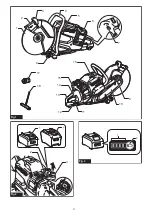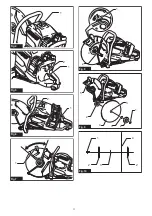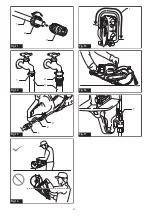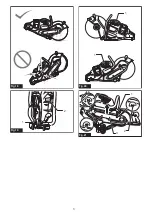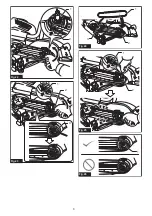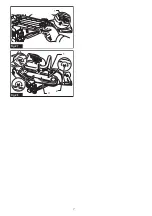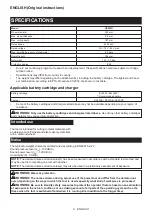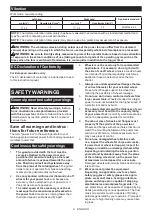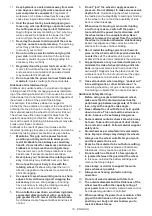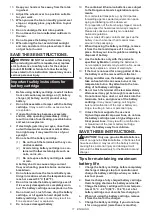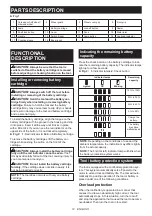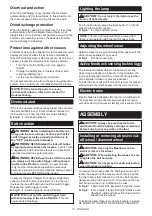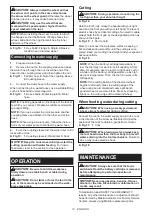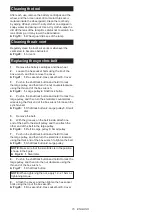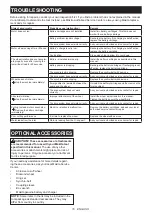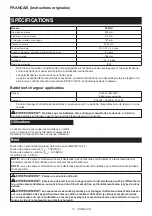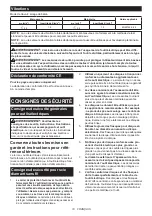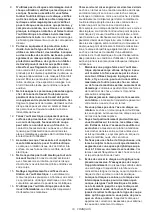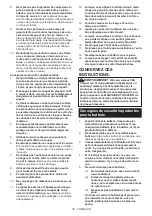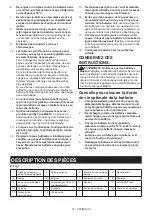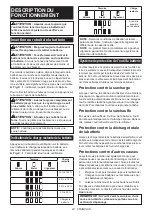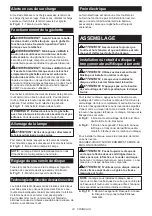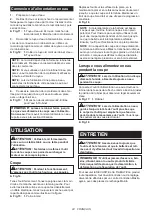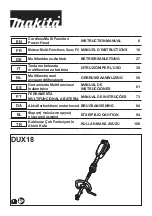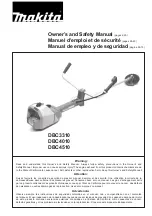
9 ENGLISH
Vibration
Work mode: concrete cutting
Left hand
Right hand
Applicable standard
a
h,W
(m/s
2
)
Uncertainty K (m/s
2
)
a
h,W
(m/s
2
)
Uncertainty K (m/s
2
)
2.5
1.5
2.5
1.5
EN60745-2-22
NOTE:
The declared vibration total value(s) has been measured in accordance with a standard test method and
may be used for comparing one tool with another.
NOTE:
The declared vibration total value(s) may also be used in a preliminary assessment of exposure.
WARNING:
The vibration emission during actual use of the power tool can differ from the declared
value(s) depending on the ways in which the tool is used especially what kind of workpiece is processed.
WARNING:
Be sure to identify safety measures to protect the operator that are based on an estimation
of exposure in the actual conditions of use (taking account of all parts of the operating cycle such as the
times when the tool is switched off and when it is running idle in addition to the trigger time).
EC Declaration of Conformity
For European countries only
The EC declaration of conformity is included as Annex A
to this instruction manual.
SAFETY WARNINGS
General power tool safety warnings
WARNING:
Read all safety warnings, instruc-
tions, illustrations and specifications provided
with this power tool.
Failure to follow all instructions
listed below may result in electric shock, fire and/or
serious injury.
Save all warnings and instruc-
tions for future reference.
The term "power tool" in the warnings refers to your
mains-operated (corded) power tool or battery-operated
(cordless) power tool.
Cordless cutter safety warnings
1.
The guard provided with the tool must be
securely attached to the power tool and
positioned for maximum safety, so the least
amount of wheel is exposed towards the oper-
ator. Position yourself and bystanders away
from the plane of the rotating wheel.
The guard
helps to protect operator from broken wheel frag-
ments and accidental contact with wheel.
2.
Use only bonded reinforced or diamond cut-off
wheels for your power tool.
Just because an
accessory can be attached to your power tool, it
does not assure safe operation.
3.
The rated speed of the accessory must be at
least equal to the maximum speed marked on
the power tool.
Accessories running faster than
their rated speed can break and fly apart.
4.
Wheels must be used only for recommended
applications. For example: do not grind with
the side of cut-off wheel.
Abrasive cut-off wheels
are intended for peripheral grinding, side forces
applied to these wheels may cause them to
shatter.
5.
Always use undamaged wheel flanges that are
of correct diameter for your selected wheel.
Proper wheel flanges support the wheel thus
reducing the possibility of wheel breakage.
6.
Do not use worn down reinforced wheels from
larger power tools.
Wheels intended for a larger
power tool are not suitable for the higher speed of
a smaller tool and may burst.
7.
The outside diameter and the thickness of your
accessory must be within the capacity rating
of your power tool.
Incorrectly sized accessories
cannot be adequately guarded or controlled.
8.
The arbour size of wheels and flanges must
properly fit the spindle of the power tool.
Wheels and flanges with arbour holes that do not
match the mounting hardware of the power tool
will run out of balance, vibrate excessively and
may cause loss of control.
9.
Do not use damaged wheels. Before each
use, inspect the wheels for chips and cracks.
If power tool or wheel is dropped, inspect for
damage or install an undamaged wheel. After
inspecting and installing the wheel, position
yourself and bystanders away from the plane
of the rotating wheel and run the power tool
at maximum no load speed for one minute.
Damaged wheels will normally break apart during
this test time.
10.
Wear personal protective equipment.
Depending on application, use face shield,
safety goggles or safety glasses. As appro-
priate, wear dust mask, hearing protectors,
gloves and shop apron capable of stopping
small abrasive or workpiece fragments.
The
eye protection must be capable of stopping flying
debris generated by various operations. The dust
mask or respirator must be capable of filtrating
particles generated by your operation. Prolonged
exposure to high intensity noise may cause hear
-
ing loss.
Summary of Contents for CE001G
Page 2: ...2 17 1 2 4 3 6 5 16 15 14 12 11 9 13 10 18 7 8 Fig 1 3 1 1 2 Fig 2 1 2 Fig 3 ...
Page 3: ...3 1 Fig 4 1 2 Fig 5 2 1 Fig 6 1 Fig 7 1 2 3 4 Fig 8 3 4 2 5 2 5 1 Fig 9 2 3 4 1 2 Fig 10 ...
Page 4: ...4 1 2 3 Fig 11 1 2 3 Fig 12 1 2 3 Fig 13 Fig 14 1 Fig 15 Fig 16 1 Fig 17 ...
Page 5: ...5 Fig 18 1 2 Fig 19 1 1 Fig 20 1 2 3 Fig 21 ...
Page 6: ...6 1 2 Fig 22 1 2 3 Fig 23 1 2 3 Fig 24 1 2 Fig 25 1 Fig 26 ...
Page 7: ...7 1 Fig 27 1 2 3 Fig 28 ...
Page 106: ...106 ...
Page 107: ...107 ...


